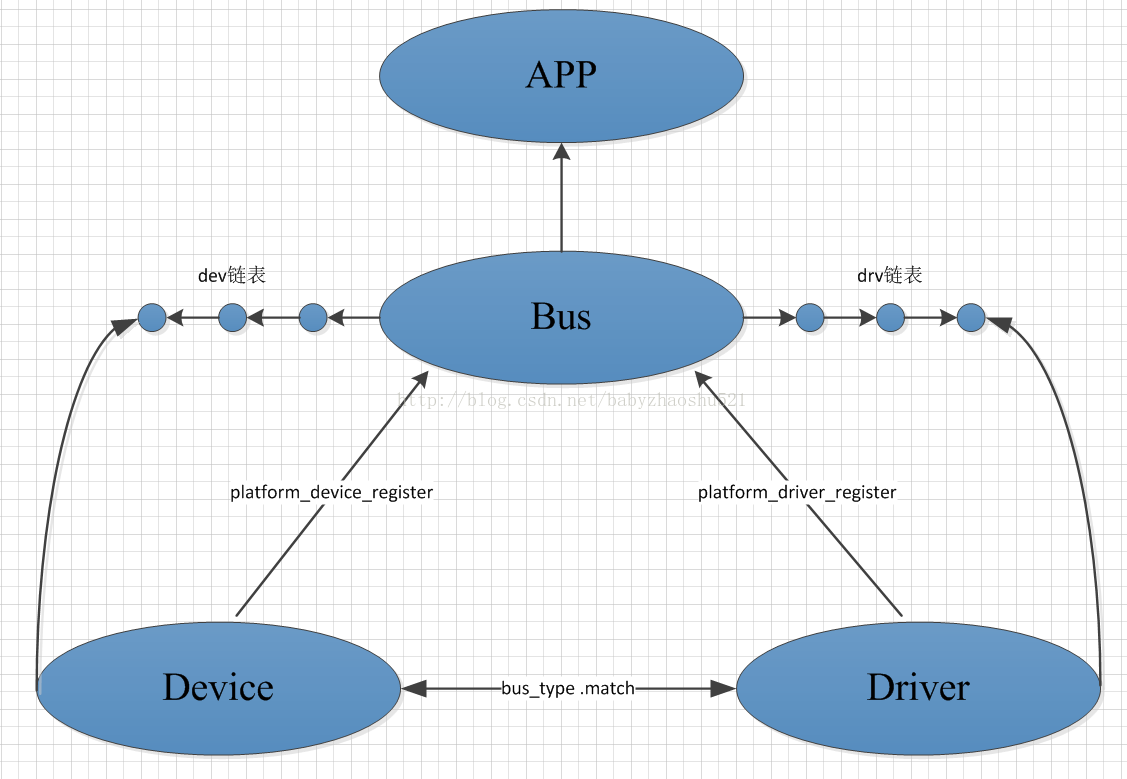Linux设备管理(四):总线、设备、驱动三者之间的联系
/************************************************************************************
*本文为个人学习记录,如有错误,欢迎指正。
* https://www.cnblogs.com/andtt/articles/2178905.html
* https://blog.csdn.net/yueqian_scut/article/details/46694417
* https://blog.csdn.net/babyzhaoshu521/article/details/60350843
************************************************************************************/
1. 总线
在物理层面上,总线代表着同类设备需要共同遵守的工作时序,不同的总线对于物理电平的要求是不一样的,对于每个比特的电平维持宽度也是不一样,而总线上传递的命令也会有自己的格式约束。如I2C总线、USB总线、PCI总线等等。以I2C总线为例,在同一组I2C总线上连接着不同的I2C设备。
在软件层面上,总线的主要作用是管理设备与驱动。
Linux内核中使用struct bus_type描述一个总线,其中包含了该总线的所有信息。

//所在文件/kernel/drivers/base/base.h struct bus_type { const char *name; //总线类型名称 struct bus_attribute *bus_attrs; //总线属性 struct device_attribute *dev_attrs; //设备属性 struct driver_attribute *drv_attrs; //驱动程序属性 int (*match)(struct device *dev, struct device_driver *drv); int (*uevent)(struct device *dev, struct kobj_uevent_env *env); int (*probe)(struct device *dev); int (*remove)(struct device *dev); void (*shutdown)(struct device *dev); int (*suspend)(struct device *dev, pm_message_t state); int (*resume)(struct device *dev); const struct dev_pm_ops *pm; struct bus_type_private *p; }; struct bus_type_private { struct kset subsys; struct kset *drivers_kset; struct kset *devices_kset; struct klist klist_devices; struct klist klist_drivers; struct blocking_notifier_head bus_notifier; unsigned int drivers_autoprobe:1; struct bus_type *bus; };
2. 设备
设备代表真实的、具体的物理器件。在软件层面上,用器件的独特的参数属性来代表该器件。如I2C总线上连接的I2C从设备都有一个标识自己的设备地址,由这个设备地址来确定主设备发过来的命令是否该由它来响应。
struct device是一个基类,被设备相关的数据结构包含,其中包含了该设备的信息。

struct device {
struct device *parent;
struct device_private *p;
struct kobject kobj;
const char *init_name; /* initial name of the device */
struct device_type *type;
struct mutex mutex; /* mutex to synchronize calls to its driver.*/
struct bus_type *bus; /* type of bus device is on */
struct device_driver *driver; /* which driver has allocated this device */
void *platform_data; /* Platform specific data, device core doesn't touch it */
struct dev_pm_info power;
#ifdef CONFIG_NUMA
int numa_node; /* NUMA node this device is close to */
#endif
u64 *dma_mask; /* dma mask (if dma'able device) */
u64 coherent_dma_mask;
struct device_dma_parameters *dma_parms;
struct list_head dma_pools; /* dma pools (if dma'ble) */
struct dma_coherent_mem *dma_mem; /* internal for coherent mem override */
struct dev_archdata archdata;
#ifdef CONFIG_OF
struct device_node *of_node;
#endif
dev_t devt; /* dev_t, creates the sysfs "dev" */
spinlock_t devres_lock;
struct list_head devres_head;
struct klist_node knode_class;
struct class *class;
const struct attribute_group **groups; /* optional groups */
void (*release)(struct device *dev);
};
struct device_private {
struct klist klist_children;
struct klist_node knode_parent;
struct klist_node knode_driver;
struct klist_node knode_bus;
void *driver_data;
struct device *device;
};
3. 驱动
驱动代表着操作设备的方式和流程。驱动主要包括两部分,第一是通过对SoC的控制寄存器进行编程,按总线要求输出时序和命令,成功地与外围设备进行交互;第二是对第一步中得到的数据进行处理,并向应用层提供特定格式的数据。
struct driver是一个基类,被驱动相关的数据结构包含,其中包含了该驱动的信息。

struct device_driver { const char *name; struct bus_type *bus; struct module *owner; const char *mod_name; /* used for built-in modules */ bool suppress_bind_attrs; /* disables bind/unbind via sysfs */ #if defined(CONFIG_OF) const struct of_device_id *of_match_table; #endif int (*probe) (struct device *dev); int (*remove) (struct device *dev); void (*shutdown) (struct device *dev); int (*suspend) (struct device *dev, pm_message_t state); int (*resume) (struct device *dev); const struct attribute_group **groups; const struct dev_pm_ops *pm; struct driver_private *p; }; struct driver_private { struct kobject kobj; struct klist klist_devices; struct klist_node knode_bus; struct module_kobject *mkobj; struct device_driver *driver; };
4. 总线、设备、驱动三者之间的联系

上图为平台总线设备驱动模型的整体框架。
在总线设备驱动模型中,需关心总线、设备和驱动这3个实体,总线将设备和驱动绑定。
当系统向内核注册每一个驱动程序时,都要通过调用驱动注册函数(xxx_driver_register)将驱动程序注册到总线,并将其放入所属总线的drv链表中,注册驱动的时候会调用所属总线的match函数寻找该总线上与之匹配的每一个设备,如果找到与之匹配的设备则会调用相应的probe函数将相应的设备和驱动进行绑定;同样的当系统向内核注册每一个设备时,都要通过调用设备注册函数(xxx_device_register)将设备注册到总线,并将其放入所属总线的dev链表中,注册设备的时候同样也会调用所属总线的match函数寻找该总线上与之匹配的每一个驱动程序,如果找到与之匹配的驱动程序时会调用相应的probe函数将相应的设备和驱动进行绑定;而这一匹配的过程是由总线自动完成的。
总线在匹配设备和驱动之后驱动要考虑一个这样的问题,设备对应的软件数据结构代表着静态的信息,真实的物理设备此时是否正常还不一定,因此驱动需要探测这个设备是否正常。总线的管理代码中会有这样的逻辑:
if(match(device, driver) == OK) driver->probe();
总线匹配设备和驱动之后,驱动探测到设备正常,开始创建设备文件。调用class_create()、device_create()函数在/dev目录下创建相应的设备文件,其内部原理是通过sysfs文件系统、uevent事件通知机制和后台应用服务mdev程序配合能够成功地在/dev目录创建对应的设备文件。详见Linux设备文件的创建。




